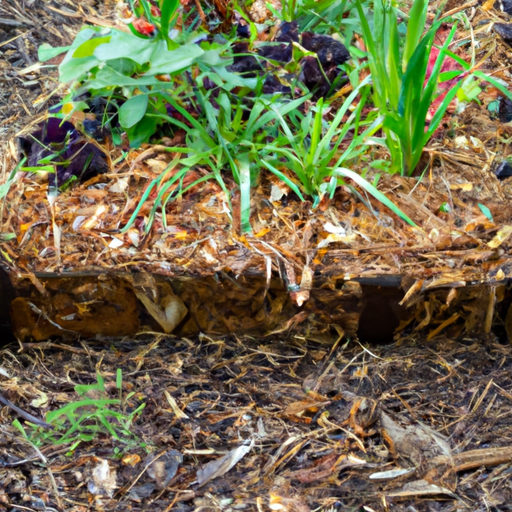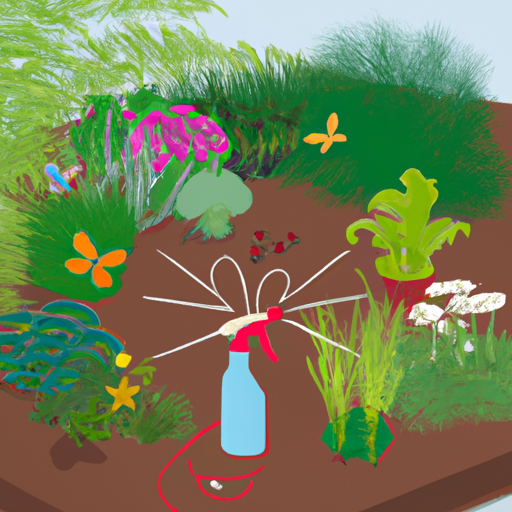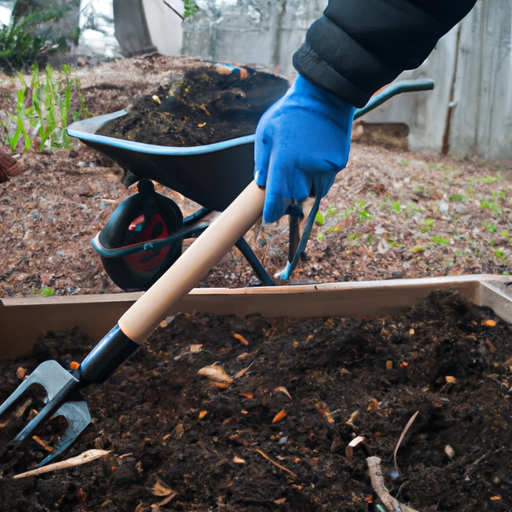Are you tired of constantly battling with weeds and pests in your garden? Are you looking for a natural and sustainable way to nourish your plants without using harmful chemicals? Look no further than organic mulching techniques.
As a Master Gardener, I have found that one of the most effective ways to keep plants thriving is by using various types of organic materials as mulch. Organic mulch not only helps retain moisture in the soil, but also adds nutrients as it decomposes. This can lead to healthier plants, improved soil structure, and reduced weed growth.
In this article, we will explore different types of organic mulches such as straw, leaves, grass clippings, and compost. We will also discuss how to properly apply them to your garden beds and containers for optimal results. With these simple yet powerful techniques at your disposal, you’ll be on your way to a vibrant and productive garden in no time!
Benefits Of Organic Mulching
Organic mulching is an essential practice for any gardener who wants to keep their plants healthy and thriving.
One of the most significant benefits of organic mulching is nutrient retention, which is critical for providing your plants with the necessary nutrients they need to grow strong.
Additionally, soil moisture can be preserved through proper organic mulching techniques, keeping the ground moist enough for plant roots to absorb water efficiently.
Organic mulching also assists in weed suppression by preventing light from penetrating the soil surface where weeds would otherwise germinate.
Finally, organic mulch can assist in pest control by creating a barrier that makes it more difficult for insects and other pests to reach your plants’ roots while also improving soil fertility over time as it decomposes naturally.
Types Of Organic Mulch
As we’ve already discussed the extensive benefits of organic mulching, it’s now time to delve into the various types of mulch available for your garden. Before you choose a particular material, consider its texture and nutrient composition as well as availability in your area. Here are some popular options:
– Grass clippings: an excellent source of nitrogen that also retains water
– Leaves: high in carbon content that improves soil structure while reducing weed growth
– Pine needles: acidic in nature which makes them ideal for plants with low pH requirements
– Wood chips: long-lasting and perfect for creating pathways or decorative borders
Now that you have a better idea about different mulching materials, let’s talk about frequency.
Mulch should be applied annually at least 2 inches deep around plants after they have established themselves in the ground. However, if you’re using grass clippings or leaves, you may need to top up more frequently.
As a Master Gardener, I highly recommend choosing organic mulch over synthetic alternatives because it enriches soil quality naturally without introducing harmful chemicals. By adopting these techniques and selecting suitable materials according to your needs, you’ll give your garden all the nourishment it requires to thrive year-round.
Applying Organic Mulch To Garden Beds
As a Master Gardener, I highly recommend applying organic mulch to your garden beds for healthier plants. Not only does it retain moisture and suppress weeds, but it also adds nutrients to the soil as it breaks down over time. Mulching frequency is key – apply a layer of 2-3 inches once or twice per year depending on the material used. Speaking of materials, there are plenty of options available such as shredded leaves, straw, grass clippings, and even newspaper. However, the best materials for long-term use include wood chips and bark since they decompose slowly and provide consistent benefits to your plants. Use this helpful table below as a guide when choosing which type of organic mulch will work best for your garden:
| Material | Pros | Cons |
| — | — | — |
| Shredded Leaves | Provides good nutrient content; easily accessible | Can mat together if not turned regularly |
| Straw | Inexpensive; easily accessible | May contain weed seeds |
| Grass Clippings | Abundant in summer months; high nitrogen content | Can compact and smell bad if applied too thickly |
| Newspaper | Free or cheap; great at suppressing weeds | Needs to be layered thickly |
Incorporating organic mulch into your gardening routine can greatly benefit your plants while reducing maintenance needs. Experiment with different materials and frequencies until you find what works best for you!
Applying Organic Mulch To Containers
As we continue our journey towards creating an organic and thriving garden, let’s shift our focus to container gardening. Containers are a great way to grow plants in limited spaces or simply add some greenery to your porch or balcony. When it comes to choosing the right container for your plants, there are various materials available such as terracotta, plastic, metal, and even fabric pots. Each material has its own benefits and drawbacks, so consider the specific needs of your plant before making a choice.
Once you have selected the perfect container for your plant, it is time to apply organic mulch to ensure its growth and health. Here are four techniques that will help keep your potted plants happy:
1. Use shredded leaves: This readily available option works wonders when applied around the base of newly planted containers.
2. Layer with newspaper: A thick layer of newspaper helps retain moisture while also providing essential nutrients as it decomposes over time.
3. Try straw: Straw not only looks aesthetically pleasing but can act as insulation during extreme weather conditions.
4. Consider compost: A well-composted mixture is rich in nutrients and promotes healthy root development.
Incorporating these organic mulching techniques into your container gardening routine will create a sustainable environment that supports long-term plant growth and ensures their continued vitality throughout each season.
Remember that every type of material requires different care; by paying attention to the unique needs of each plant, you’ll be able to reap the rewards of bountiful harvests year after year without any harmful chemicals or practices necessary.
Tips For Maximizing Your Mulching Results
To truly maximize the benefits of organic mulching, it’s important to pay attention to both frequency and depth.
Mulching frequency depends largely on your climate and soil type, but a general rule of thumb is to add a fresh layer every 1-2 years. This not only helps suppress weeds and retain moisture, but also encourages healthy microbial activity in your soil.
When it comes to ideal mulching depth, aim for around 2-3 inches for most plants. Too little won’t provide adequate coverage, while too much can suffocate roots or encourage pests like voles.
By finding the right balance between frequency and depth, you’ll be able to keep your plants thriving all season long.
Frequently Asked Questions
How Often Should I Apply Organic Mulch To My Garden Beds Or Containers?
As a Master Gardener, I often get asked about the benefits of mulching and how frequently it should be done.
Mulch acts as a protective layer for your garden beds or containers by retaining moisture in the soil, suppressing weeds, regulating temperature, and adding nutrients to the soil as it breaks down.
In terms of frequency, it depends on various factors such as climate, type of mulch used, and plant species. Generally speaking, organic mulch should be applied once or twice a year – preferably during spring and fall. However, keep an eye out for signs that may indicate the need for more frequent applications such as dry weather conditions or decomposition of existing mulch.
Remember that too much mulch can also have negative effects on your plants so aim for a thickness of 2-3 inches only.
By incorporating regular mulching practices into your gardening routine, you’ll surely see healthier and thriving plants in no time!
Can I Use Any Type Of Organic Material As Mulch, Or Are There Specific Types That Work Best?
When it comes to using organic mulch in your garden, not all materials are created equal.
While any type of organic material can technically be used as mulch, some types work better than others for certain plants and situations.
For example, wood chips or shredded leaves make great all-purpose mulches that help retain moisture and suppress weeds, while straw is ideal for vegetable gardens because it allows air and water to circulate around the plants.
There are even more specialized options available, such as cocoa bean shells (which deter slugs) or pine needles (which acidify soil).
By choosing the right types of organic mulch for your specific needs, you’ll reap the benefits of healthier plants with less maintenance required.
Does Organic Mulch Attract Pests Or Insects To My Garden?
When it comes to using organic mulch in your garden, there are both pros and cons to consider.
On the one hand, organic mulch can help retain moisture in the soil, suppress weed growth, and provide nutrients as it decomposes.
However, some types of organic materials may attract pests or insects to your garden. To prevent this from happening, it’s best to use high-quality compost or well-aged manure for your mulching needs.
Additionally, you should avoid piling too much mulch around the base of plants, which can create a haven for pests and diseases.
By following these best practices, you can enjoy all the benefits of organic mulching techniques without having to worry about any unwanted visitors in your garden.
How Deep Should I Apply Organic Mulch To My Garden Beds Or Containers?
Mulching is an essential part of gardening as it provides numerous benefits to your plants.
One common question that gardeners ask is how deep should organic mulch be applied to their garden beds or containers?
Some may worry that applying too much mulch can suffocate plant roots or cause waterlogging, but this concern can be overcome by understanding the benefits of deep mulching.
A layer of at least 3-4 inches of organic mulch not only suppresses weeds and conserves moisture but also regulates soil temperature and improves soil structure over time.
Additionally, there are alternative ways to use organic materials as mulch such as using leaves or grass clippings instead of wood chips or straw.
As a Master Gardener, I recommend experimenting with different types and depths of organic mulch to find what works best for your specific plants and growing conditions.
Can I Use Leaves Or Grass Clippings From My Own Yard As Organic Mulch?
Yes, you can absolutely use leaves or grass clippings from your own yard as organic mulch! Using fresh grass clippings as mulch is a great way to add nutrients back into the soil for your plants.
Grass contains nitrogen, which is essential for plant growth and development. Additionally, using homemade organic mulch has many benefits such as reducing weed growth, conserving moisture in the soil, and regulating soil temperature.
Just be sure to avoid using diseased or pesticide-treated materials in your homemade mulch.
Happy gardening!
Conclusion
In conclusion, organic mulching is a great way to keep your plants healthy and thriving. By applying it regularly, you can help retain moisture in the soil while also adding valuable nutrients back into it.
The type of material used for mulch may vary based on what’s available in your area or personal preference. However, before choosing any materials as mulch for your garden beds or containers, make sure they are free from pests and diseases that could harm your plants.
Additionally, remember not to apply too much mulch, which can prevent water from reaching the roots of your plants. As Master Gardeners know well, taking care of our gardens requires time and effort.
But by using organic mulching techniques like those discussed here, we can create an environment that promotes plant growth and health naturally. So why wait? Start experimenting with different types of organic mulch today and see how quickly your garden thrives!






